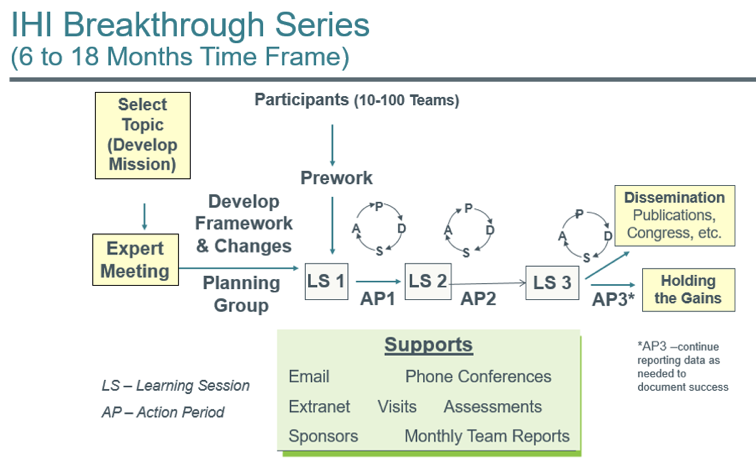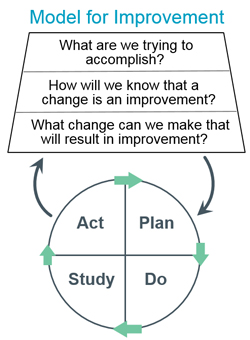
Kelly McCutcheon Adams (Senior Director) from the Institute for Healthcare Improvement (IHI) discusses how the IHI Breakthrough Series (BTS) Model can be used to accelerate the spread of improvements across multiple settings.
What do reducing sepsis mortality in Australia, reducing neonatal mortality in India, improving care for nursing home residents in Denmark, increasing high school readiness for students in California in the United States, reducing nosocomial infections in the UK, and reducing teenage pregnancy in South Carolina in the United States all have in common? They are all improvement Collaboratives that have leveraged the Institute for Healthcare Improvement’s (IHI) Breakthrough Series (BTS) Model to accelerate the spread of improvements across multiple settings.

Over the past two decades, the IHI BTS Collaborative model has been used across industries including health care, education, and social services agencies, and across many countries and populations. It is not a model that is topic-specific but rather lends itself to being used when a topic reaches a certain level of developmental “ripeness”. Although the word collaborative gets used in many ways in many settings, use of the BTS Model in the traditional sense refers to a specific set of design criteria. These include having 10-100 participating teams, running three in-person Learning Sessions, have the overall program lasting 6-18 months, and making use of a Change Package, a Measurement Strategy, and an execution model like the Model for Improvement to keep teams engaged, motivated, and staying in action throughout the length of the program.
Topic selection is the first key step in running a collaborative. Topics that are ripe meet three criteria: there is a gap between evidence of what is possible and typical practice, there are examples of how to do it better, and there is a positive business case for undertaking the improvement work which sometimes refers to cost but not always. Exploring these three criteria of ripeness sometimes show potential Collaborative leaders that more work is needed to develop the topic before starting a BTS or that, in fact, the topic is so well-developed that a lower-cost resource could be used instead like putting together a toolkit or How-To-Guide. Understandably, finding this “Goldilocks Zone” for Collaborative topics is critical to launching a successful Collaborative.
After a topic has been selected, Collaborative leaders (Director, Improvement Advisor, and Senior Sponsor) convene an Expert Meeting to surface the evidence-base in greater detail to start the development of the Change Package and the corresponding Measurement Strategy. The Expert Meeting provides an opportunity to recruit experts to serve as a faculty for the Collaborative to help bring the Change Package to life in useful ways for participants. Then the faculty work together with the Collaborative leaders to develop those key documents, recruit participating teams, and get the teams engaged in Prework activities. The Prework ensures that teams arrive to the first Learning Session with a clearer understanding of their own current systems in relation to the Collaborative topic, and are ready to jump into learning about the Change Package and leave ready to take action back at home.
The three in-person Learning Sessions are great opportunities for learning, sharing, building will, and establishing peer support with like-minded organizations facing similar struggles. These are high-energy events which are meant to give teams confidence that they are leaving with the will, ideas, and execution model needed to start testing changes immediately upon return to their home organizations. This pace is set by asking teams to share their first PDSA (Plan-Do-Study-Act) cycle via the listserv (an email distribution list) by the Tuesday after the Learning Session. Yes, that very next Tuesday! This sense of urgency helps teams start with small enough tests and not get stymied by “analysis paralysis” once they depart the Learning Session.

Having teams share their PDSA’s via the Collaborative listserv so soon after the Learning Session tees up the first All-Collaborative monthly call a couple weeks later. Teams are actively testing the change package in their pilot environment, are sharing their learning via monthly reports, and are using the Measurement Strategy to gauge whether or not the changes are improvements. The faculty and Collaborative leadership are staying connected with teams throughout these Action Periods (the spans between the Learning Sessions) to coach them through struggles and highlight successes for the whole Collaborative to learn from.
The” All Teach, All Learn” motto of the BTS Collaborative model is the key fuel that helps the Collaborative succeed. Building a culture of transparency, candour, and mutual learning is foundational to helping all the teams learn from each other’s failures, victories, and interesting challenges. This culture is nourished through the monthly phone calls, report summaries, an active listserv, and the periodic return to the energetic and intensive Learning Sessions.
The final Learning Session focuses on celebration and the important work of Holding the Gains (sustaining improvements) and thoughtful spread into other settings beyond the pilot site. Collaborative leaders turn their attention towards dissemination of the learning and possible next steps which could include running another Collaborative, running a new one on a different topic, publishing the learning, and running events like a Learning Congress to share the learning.
The flexibility of the BTS Model across contexts, topics, and countries makes it a great choice when there is will in the system to seek breakthrough results on a vexing issue, and when the topic is ripe for success. We look forward to seeing where else it can be leveraged to reduce harm, improve quality of life, and reduce waste.